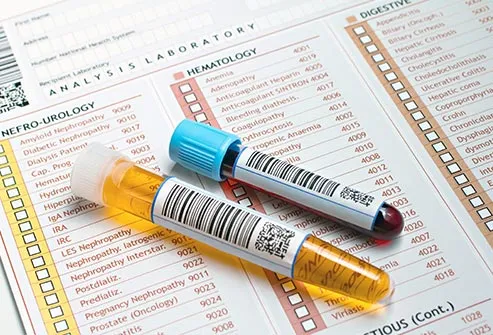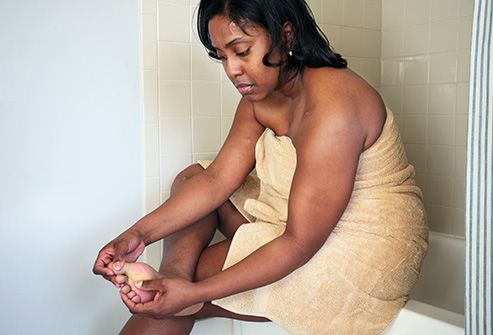Signs of Diabetic Nerve Damage

What Is It?
Diabetes can damage your peripheral nerves, the ones that help you feel pain, heat, and cold. Called DPN for short, this condition most often affects your feet and legs. It can affect your hands and arms, too. It causes odd feelings in your skin and muscles, as well as numbness that could lead to injuries you don't realize you have.
Swipe to advance

2
/
13
What Causes It?
Someone who has diabetes is more likely to have high levels of glucose and triglycerides (a kind of fat) in their blood. Over time, these damage the nerves that send pain signals to your brain, as well as the tiny blood vessels that supply the nerves with nutrients. The best way to prevent or delay DPN is to control your blood sugar and blood pressure.
Swipe to advance

3
/
13
Who Gets It?
About half of people with diabetes have some kind of nerve damage. Two out of 10 people already have DPN when they're diagnosed, although it's more common the longer you've had the disease. Someone who is obese or has prediabetes or metabolic syndrome (an unhealthy combination of high blood pressure, high blood sugar, high cholesterol, and belly fat) has a greater chance of getting DPN, too.
Swipe to advance

4
/
13
Symptoms
Your feet or fingers may start to tingle or burn, like "pins and needles." The lightest touch, perhaps from sheets on your bed, might hurt. In time, your muscles can become weak, especially around your ankles. You could find it harder to balance or painful to walk.
But you may not have any symptoms, even though there's nerve damage.
Swipe to advance

5
/
13
Get Checked Regularly
When you have diabetes, it's important to see your doctor to try to catch DPN early. How often? Every year if you have type 2. For type 1, you should get tested yearly, starting either after puberty or after 5 years if you were diagnosed when you were older.
Ask your doctor about getting checked for DPN if you don't have diabetes yet but are at risk for it.
Swipe to advance

6
/
13
Doctor's Exam
Because DPN often starts in the feet and legs, your doctor will look there for cuts, sores, and circulation issues. They'll check your balance and watch you walk. They'll want to find out how well you sense changes in temperature and delicate touches like vibrations. They may place a thin piece of string or a tuning fork on your toes and feet to see if you feel it.
Swipe to advance

7
/
13
Blood and Urine Tests
These help your doctor track your blood sugar and triglyceride levels. The tests might help rule out other causes of neuropathy like kidney disease, thyroid problems, low B12 levels, infections, cancer, HIV, and alcohol abuse, which may need to be treated differently.
Swipe to advance

8
/
13
Treatment
Drugs for depression (citalopram, desipramine, nortriptyline, paroxetine) and seizures (gabapentin, pregabalin) could make your DPN hurt less, but over-the-counter painkillers may not. Products you put on your skin to numb it, like lidocaine, might also help. Nothing will reverse the nerve damage. Your doctor may suggest special exercises (physical therapy) to help you feel better and keep you moving.
Swipe to advance

9
/
13
Infection
One side effect of DPN is that you may not notice minor cuts, blisters, burns, or other injuries because you simply don't feel them. Since diabetes makes these wounds slower to heal, they might become very serious before you find them. They're far more likely to get infected. Without the proper care, you could lose a toe, your foot, or even part of your leg.
Swipe to advance

10
/
13
Charcot Foot
Severe neuropathy can weaken the bones in your foot. They could crack or break, making your foot red, sore, swollen, or warm to the touch. But because you can't feel it, you may keep walking on your foot and deform it. For example, the arch could collapse and bulge toward the ground. Caught early, your doctor can treat Charcot foot with rest, braces, and special shoes. Serious cases might need surgery.
Swipe to advance

11
/
13
Take Care of Your Feet
Every day, look for cuts, sores, or burns that you might not feel. A mirror can help with those hard-to-see places. Don't forget to check between your toes. Wash your feet daily in warm water: 90-95 F is safe. (Use a thermometer to test the temperature.) When you rest, wiggle your toes and put your feet up to help keep your blood moving. Call your doctor about any problem that doesn't clear up in a few days.
Swipe to advance

12
/
13
Wear Shoes
They protect your feet from the ground, whether it's burning hot, icy cold, or covered in rough edges. Make sure your shoes breathe, are comfortable, and have plenty of room for your toes. Bring the ones you wear most to your doctor when you go for your checkup. You may need special shoes or inserts when you have foot problems.
Swipe to advance

13
/
13
Other Types of Neuropathy
Diabetes can also cause nerve problems other places in your body.
Autonomic is damaged nerves that help control your bladder, stomach, eyes, blood vessels, and other body functions.
Proximal is in your hip, butt, or thigh (usually on just one side), which makes it hard to move.
Focal hurts single nerves, often in your leg, hand, head, or chest and belly.
Swipe to advance
- Get link
- X
- Other Apps